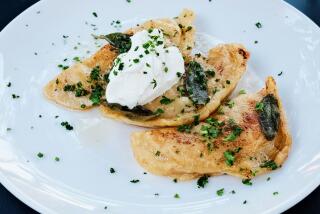Farmers Markets: Changes in South Pasadena, Westwood
- Share via
Two popular and successful farmers markets, in South Pasadena and Westwood, are in the process of replacing the veteran managers who helped build them.
Greta Dunlap, a star among managers, helped establish the South Pasadena farmers market in 1999, then left after a year to run the prosperous Beverly Hills farmers market. Her reputation grew, and in 2010 she returned to manage the South Pasadena market, upgrading both its quality and integrity. Two weeks ago, however, in a letter to the market’s sponsor, the South Pasadena Chamber of Commerce, she abruptly resigned, effective last Thursday.
What happened? In a carefully worded statement, Dunlap said, “It’s been a challenge to get … proper staffing and marketing to support the efforts of the market manager, farmers and vendors.”
Chamber Chief Executive Scott Feldmann said, “I was completely surprised, because we just hired additional staffing support for the market.” The chamber will run the market with existing staff while conducting a search for a new manager, he added.
Meanwhile, it looks as if the largest operator of farmers markets in Southern California, Raw Inspiration, will take over running the Westwood farmers market from Stephen Whipple, a longtime manager at the venue.
The old Westwood farmers market on Weyburn Avenue was formerly one of the busiest in the Southland, but it closed in 2006, and three attempts to revive it, at Broxton Avenue and Veterans’ Garden, failed to thrive. A year ago, after the Broxton venue shifted to Thursday afternoon, business started to improve, and it seemed that the Westwood market might flourish again.
Meanwhile, 13 months ago, the market’s sponsor, the Westwood Village Improvement Assn., transformed itself from a nonprofit to a business improvement district and started to take a more active role in planning the market. In May it issued a request for proposals to run the market; according to Andrew Thomas, the organization’s executive director, this was partly standard business procedure, but his board also wanted to increase the number of farmers in the market and reduce the prepared food and craft vendors competing with local merchants. Only Raw Inspiration submitted a proposal.
Whipple says that after much agonizing, he chose not to submit a proposal. He felt that he had nursed the market through tough times with little logistical support from the association and that it was unfair that the sponsor would consider outside proposals just as it was becoming profitable.
Thomas says that the association contacted about a dozen market operators about running Westwood and was surprised that only one responded. The WVIA board will vote on Raw Inspiration’s proposal at a public meeting at 8:30 a.m. Thursday at Skylight Gardens restaurant, 1139 Glendon Ave.
Cool time for Asian pears
When the heat is brutal, as it has been for much of the last month, no fruit is more refreshing than a chilled Asian pear, straight from the refrigerator. Not just any Asian pear, but Shinseiki, a round, yellow-skinned Japanese variety with very firm, crunchy flesh and mildly sweet flavor. Yes, there are sweeter pears out there, like the brown-skinned Hosui and Shinko, but their high sugar actually detracts from their refreshing qualities. The juicy, crunchy flesh and delicate flavor of a good Shinseiki provide a pleasingly simple, almost Zen-like experience.
Shinseiki, whose name means “new century,” is a cross of 20th Century and Chojuro, introduced in 1945. Firm and productive, it was one of the leading varieties planted in California when Asian pears were commercialized in the 1970s and ‘80s but has largely been displaced in cultivation by brown-skinned varieties, which are not only sweeter but also hide scuffs and bruises better. Shinseiki is getting harder to find at farmers markets and mainstream supermarkets, though it’s still readily available at Asian groceries.
The best Asian pears are grown in the Sierra foothills east of Sacramento, where they were planted by Japanese immigrants and their children starting more than a century ago. Most of that fruit stays upstate, and we are fortunate that Jeff Rieger of Penryn Orchard Specialties drives 400 miles each Wednesday to sell his pears and other fruits at the Santa Monica farmers market. Recently, however, he’s become discouraged by the modest demand for his Shinseikis and has considered not harvesting his trees.
Part of the problem, Rieger says, is the light-skinned fruits so readily show scuffs from limb and leaf rubs. Ironically, the ripest, best-tasting specimens are most subject to such blemishes, and Rieger, who curates his fruits with almost maniacal intensity, says that he has been mistaken in culling Shinseikis with such minor cosmetic flaws. He has decided to give the variety another shot next Wednesday.
In selecting Shinseikis, look for fruit that is fully light yellow, not tinged with green, although a very dark yellow could indicate overmaturity later in the season. Like other Asian pears, the variety is attractive to coddling moths, so watch out for the telltale dark powdery substance at the bottom, and cut open the pear before biting into it if you suspect that an intruder may be present. Also, look for smooth skin, especially at the bottom, where pebbliness can indicate excessively coarse flesh.
Shinseikis are also imported from Japan, where they are grown in protective bags to keep the fruit unblemished. These can be very fine but typically show up later in the season, and right now, in the dog days of late summer, is this variety’s time to shine.
More to Read
Eat your way across L.A.
Get our weekly Tasting Notes newsletter for reviews, news and more.
You may occasionally receive promotional content from the Los Angeles Times.










